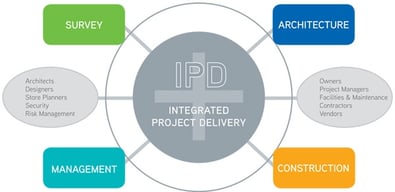 Look up “Integrated Project Delivery (IPD)” and you’ll find people saying that it is “a growing trend” in construction, particularly in the healthcare field. This viewpoint is hard to dispute, if only because there is so little statistical evidence to be found, one way or the other.
Look up “Integrated Project Delivery (IPD)” and you’ll find people saying that it is “a growing trend” in construction, particularly in the healthcare field. This viewpoint is hard to dispute, if only because there is so little statistical evidence to be found, one way or the other.
Anecdotally, it is safe to say that more construction projects use IPD heading into 2018 than they did a few years ago.
What has long been one of the biggest problems with IPD is defining exactly what it is. In its purest sense, IPD entails a multi-party contractual agreement that binds together the owner, designer and contractors, at a minimum. It may include others as well.
Since the outset of IPD, some projects that simply brought the key project team members together early in the process began flying the IPD flag. These “IPD-lite” projects muddy the issue and, to some degree, reduce its impact. Adding a dose of confusion to an unorthodox innovation such as IPD—especially in this famously change-averse industry—can only exacerbate the challenge of gaining traction among the many ways to approach a project.
Yet, IPD flourished in some places and sectors. The perception is that the East and West Coasts have the preponderance of IPD projects, with most of the projects completed for the Healthcare sector (where it all began in the U.S.). While this may be the case, other geographic areas and market sectors are represented as well.
WHAT'S NEXT FOR IPD?
As familiarity with IPD has grown in the industry—if only because it has been around now and discussed for more than a decade, and not necessarily for its actual frequency of use—understanding of its purpose and meaning has seemingly increased. We see fewer examples of marketing departments stretching the limits in describing a project as IPD.
While unlikely to ever be the industry’s “great answer” to project delivery, IPD is nonetheless a viable approach to consider under certain circumstances. Fact is, it was never supposed to be the answer … just an answer.
Sutter Health’s Bob Mitsch, VP of Facility Planning and Development and a key player in the Sutter Lean Summit, stresses that IPD is not for every project. One limitation, he said, is that IPD requires more time and commitment than many owners or AEC firms are accustomed or willing to devote.
“It’s a very intensive type of project delivery,” Mitsch said. “It takes a lot of effort to do it right. A lot of administration and a big upfront investment in time for all the parties involved. The simpler projects, the ones with much less risk and dollars involved, don’t require that.”
While some argue that “IPD-lite” is as good as the real thing, true devotees say that the contractual obligation is what holds it together. This dichotomy was detailed in the Lean Construction Institute (LCI)’s Motivation & Means publication’s profile of the Autodesk Building Innovation Learning and Design Space project in Boston.
The architects uniformly believe that their experiences on IPD-lite projects, working collaboratively but without a formal IPD contract, had value: “You don’t need an IPD contract to act accordingly. You just need really intelligent, thoughtful, client-centric team members who are willing to engage as a team and deliver as a team.” While noting collaborative behavior can occur outside of IPD, they also acknowledge the significant resilience and protection IPD provides when things don’t go well.
As a senior architect speculated, “If this were a typical project, we would likely be suing each other. I guarantee it. There were a lot of misses. In that sense, the IPD contract has been very helpful because people have had a ‘We’re all in this together’ attitude throughout the project.”
He contrasted this positive experience with a concurrent project: “I had a phone call yesterday about another project where that was not the case. There was a clear mistake made, and everybody was just gunning for everybody else. There have been plenty of times during this [Autodesk] project where, if it had a non-IPD contractual arrangement, there would have been some mistrust. Probably finger pointing.”

This article is an excerpt from PSMJ’s recently released 2018 A/E/C Firm U.S. Market Forecast, which provides a comprehensive overview of each market sector and its outlook for 2018 (and beyond) from the perspective of architecture and engineering firm owners. In addition, this document offers readers bold ideas and strategic initiatives to improve on overall performance next year. It is less a market research publication than it is a planning tool.



